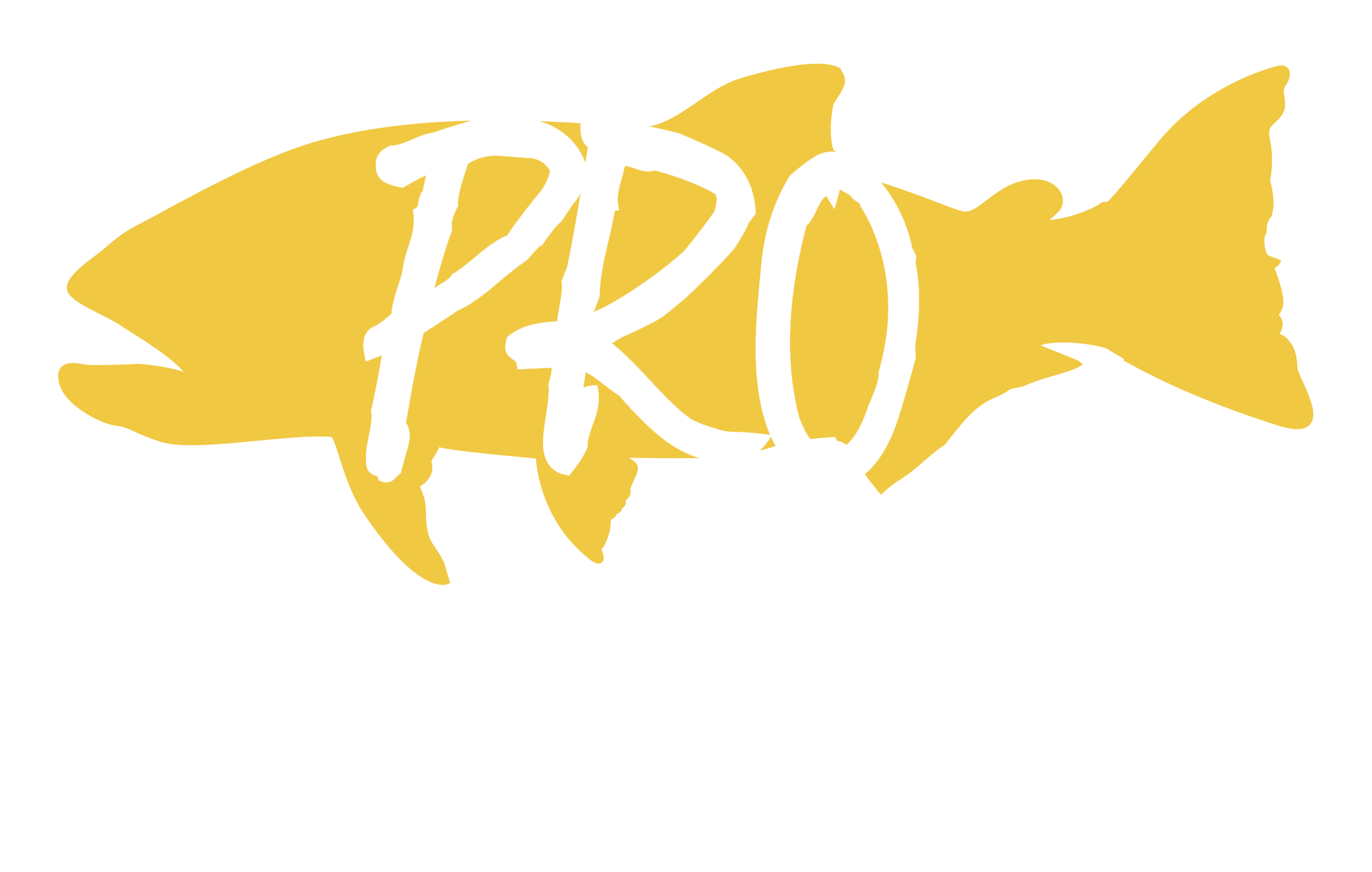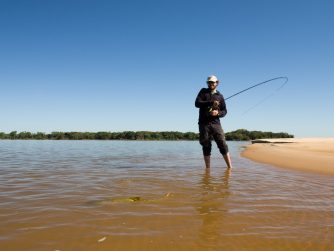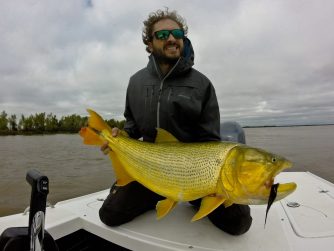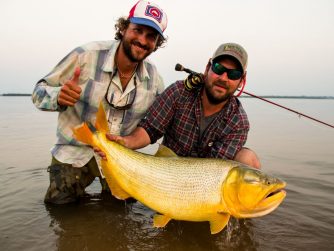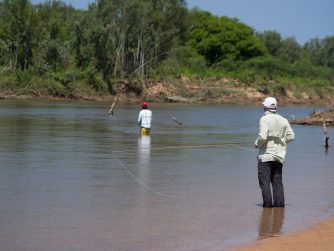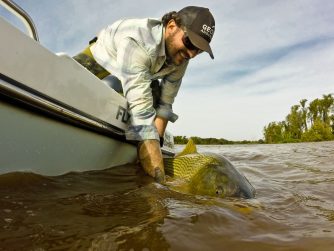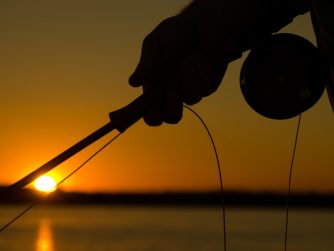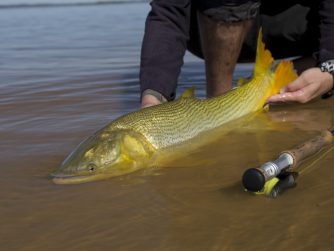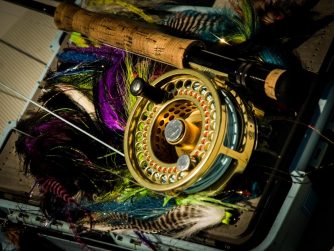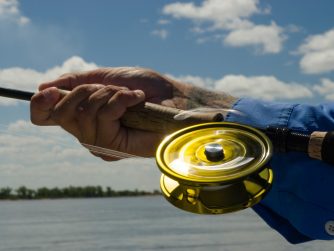Fishing the Middle Paraná
This section of the Parana River is a land of plenty when it comes to varied fish-holding structure. From downed logs and steep cut-banks to sandbars and deep edges, it has it all.
When targeting woody structure, we typically use full-floating or intermediate-sinking lines to swing flies in and around the obstructions. Although mends are sometimes needed to alter the speed or depth of the swing, the trick is to always maintain control of the line, to keep it under constant tension. Another effective tactic is to slap the fly close to the structure. The “noise” or “commotion” on the water’s surface is often enough to wake up a dormant dorado and prompt it to move for the fly.
In the lagoons, bays, and smaller black-water (tannin colored) side channels the fish can be more wary and, when that’s the case, it’s best to present the fly gently. If there are baitfish around, on the other hand, it’s more about stripping and ripping the fly in order to provoke a strike.
The final key to the middle Parana puzzle are its abundant sandbars, where we find some of the river’s best sight-fishing. These zones can be explored on foot or by boat, depending on where the dorado are patrolling. To avoid spooking fish in skinnier water, floating lines and longer leaders are the norm here. Depending on the situation, these cruising dorado can be careful and spooky, or they can shed all inhibitions and get crazy during a feeding frenzy. Fish can be found in singles, pairs and schools, and where the water clarity is good you’ll see them. In deeper water scenarios, the game changes and reading the water well and covering it thoroughly become essential to success.
The sandbar edges can be fished with floating or sinking lines. Large dorado are often found either prowling these areas or lying in wait, ready to pounce on incoming baitfish.
THE DAILY PROGRAM
After having breakfast you will be taken to the boat at 8,30am, fishing during the morning, until we make a break for lunch by the river after a good rest, will be fishing again until the sunset. Then you will be taken to the hotel to have some snacks and drink and dinner. The program runs mainly in our winter and springtime, so heat won’t be a problem at midday.
The Fishing
Dorado is one of the most exciting species anglers can catch on a fly. And this is the best section of the Paraná for landing a monster during the June through October window. You’ll also find good sight-fishing opportunities when dorado is located on the banks, where they ambush cruising sábalo. Guests will be fishing mostly from our new fleet of 21-foot Skiffs. The custom designs have 2 decks (one on the front, another one on the back), so 2 anglers can fish simultaneously.
The Parana is a structure-loaded system. Most of the time we “drift” the boats with trolling engines in order to target the nuanced natural habitat—from sunken logs and boulder gardens to small bays and side channels. Other times fish are concentrated on sandbanks, where they corral baitfish. If this is the case, we’ll often drift-fish the sand zones or wade in search of action.
Tackle:
Fly-Fishing
Floating fly lines are standard, fished with 8- or 9-weight rods. Redfish floating lines (oftentimes a size heavier than the weight of the rod) are great. Consider coldwater lines for the winter months (late June, July and August), and warm-water lines for September and October. Also, intermediate and sinking lines can be productive.
Use leader material from 50- to 80-pound test; wire from 40- to 65-pound test.
Popular dorado flies such as Andino Deceivers (4- to 7-inch streamers tied on 3/0 to 5/0 hooks) and some other patterns can be good, depending on the clarity of the water. We recommend that you buy flies from the guides—they have whatever you need, as they tie flies and know the game.
Spinning & Bait-Casting
We recommend rods between 1.80 and 2.10mts (5.9 to 6.9 footers); 10- to 20-pound or 12- to 25-pound medium- to fast-action rods are needed. Use multifilament 50 to 60 pounds test. Productive lures include Rapala Glidin Rap (size 12), Rapala Super Shad Rap (14), and Rapala X Rap. Johnson spoons (between 2 ¾ and 3 3/4 inches) are also useful, as well as poppers and soft-baits. Argentinean lures made especially for dorado are available, too. We can provide your lures, they will be customized by the guides.
Technical clothes and apparel
Been winter and springtime, we can expect any kind of weather in our section of the Parana River. Early in the morning can be humid and cold, as well as late in the afternoon. Later in the season very warm. So, be prepared to have any kind of clothes, and even a wader to patrol the sandbars or be ready to land a fish on it. Wading boots can be soft, no stones in the sandy flats.
Fly Fishing Equipment
- Rods: We recommend 9-foot 8 or 9-weight rods. Sage makes some of the best dorado rods available. In addition to a lifetime warranty, the company engineers several high-performance options perfectly suited for fishing at PRO.
- Reels: A quality fly reel is important. A strong, smooth drag is a must, as larger dorado are both strong and fast. Reels should have the capacity for the fly line and 100 to 150 yards of 30 to a 50-pound backing.
- Lines: Pack weight-forward floating fly-lines, we recomend Rio Winter Redfish or Summer Redfish (or similar). Also, consider “over-lining” your rods. For example, we often use a 9-weight floating line on an 8-weight rod, which has dual benefits: 1) It makes it easier to load the rod with less line and 2) the heavier line makes casting larger flies easier.
Additionally, we recommend bringing a fast-sinking line such as Rio’s Leviathan (or similar), which has a 26-foot, 300- to 350-grain sinking tip. Intermediate tip lines are good options too. For the colder weeks (June-August) cold water lines are recommended and for the warmer weeks (September-November) tropical lines will work fine. - Leaders: the leaders should be heavy enough to turn over big flies. Spools of mono should include 50 to 80 lbs test weights. Maxima Ultragreen Mono is a good option for leader material. An important thing to consider in a Dorado leader is the shock, or bite tippet. Bring plenty of 40 to 65 lb test steel leader for your stay.
We recommend:
– AFW Surflon Micro Ultra Leader Wire Nylon Coated 1×19 from 46 to 61 pounds test, camo color.
– AFW Surflon Micro Supreme Nylon Coated 7×7 from 40 to 65 pounds test, camo color.
Dorado Fly Patterns
In most cases, golden dorado prefers dark streamers that produce visible silhouettes. Nevertheless, there are situations when carrying a mixture of brighter colors can be effective. So don’t be afraid to experiment across the color spectrum. All flies should be tied on stout 3/0 to 5/0 hooks. Streamers can be tied from 5 to 7 inches long, or longer. However, it’s important that they’re light enough to cast. For the really big stuff, we recommend hydrophobic materials that shed water and therefore cast farther than a water-soaked material. In order to make your flies more durable, add glue or epoxy throughout the tying process if necessary.
For more details on a few of our favorite, dorado flies—including how to properly tie and fish them—follow the link.
Spinning and Baitcasting Equipments
- Rods: We recommend rods between 1.80 and 2.10mts (5.9 to 6.9 footers); 10- to 20-pound or 12- to 25-pound medium- to fast-action rods are needed.
- Reels: Open-face spinning reels are the easiest to use but, inexperienced hands, bait-casters are the easiest to use accurately and they give you the best chance to place your lure where you want it. Bait-casters should feature a high-speed retrieval ratio, as lures are normally worked very rapidly. Whichever style is your favorite, it will need to be loaded with multifilament from 50 to 60 pounds
- Leaders: Steel leaders are a must. Dorado has sharp teeth and a 10 to 14 inch, 45 to 65 lb test steel leader is needed.
- Lures: Productive lures include:
- Rapala Glidin Rap (size 12)
- Rapala Super Shad Rap (size 14)
- Rapala X Rap (size 12)
- Rapala Husky Magnum (size 15)
- Rapala X-Rap Magnum (size 15)
- Rapala BX Minnow (size 10)
- Rapala X-Rap Twitchin Mullet (size 8)
- Rapala X-Rap Saltwater SubWalk (size 9)
- Rapala X-Rap Twitchin’ Minnow (size 12)
- Rapala X-Rap Long Cast Shallow (sizes 12 and 14)
- Rapala Saltwater Skitter Walk (size 11)
- Rapala X-Rap Prop (size 11)
- Shallow Shad Rap (Size 9)
- Rapala Skitter Pop Waltwater (Size 12)
- Rapala Fat Rap (size 5)
- DT series (Size 10, 14)
- Rapala Clackin rap (Size 8)
- Rapala Clackin Minnow (Size 11)
- Johnson spoons (between 2 3⁄4 and 3 3/4 inches) are also useful, as well as poppers and soft-baits
Argentinean lures made especially for Dorado are available, too. We can provide you lures, they will be customized for Dorado fishing by the guides
